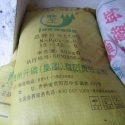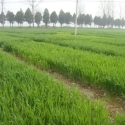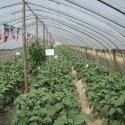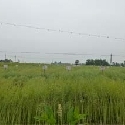06 Nov 2012
Balanced fertilization for ginger production – why potassium is important
Ginger is a leading high value crop in southeastern China and a primary source of income for the region’s farmers. Ginger rhizomes and their products are consumed as a spice, in Chinese medicine, and as a special vegetable in daily diets worldwide. Most recent statistics indicate that area planted to ginger in China is about 240,000 ha, which accounts for 48% of the total ginger crop area globally.
This paper focuses on Anhui Province, which is one of the most important ginger production regions. Nutrient management is always an important consideration for ginger because it requires large quantities of nutrients, especially K. However, farmers in Anhui typically overuse N and P, and ignore K fertilization. They are unaccustomed to applying potash in upland crops, and this region has a general lack of K fertilization products and knowledge regarding balanced fertilization. This research program in Linquan County began with a series of field experiments carried out in 2002 and 2003 in the towns of Gaotang and Tanpeng to test fixed ‘optimum’ (OPT) NPK treatments, as well as corresponding nutrient omission treatments. Recommended N, P, and K rates in the OPT considered both the average rates traditionally used by local farmers as well as soil analysis and fertilizer recommendation according to the Agro-Services International (ASI) method (Portch and Hunter, 2002), which is used by the National Laboratory of Soil Testing and Fertilizer Recommendations in Beijing. According to traditional practice, basal fertilization included all of the P and K plus 60% of the total N rate. The remaining N was split between topdressings applied at the vigorous growth stage and rhizome expansion growth stage.
Fixed OPT field trials were also conducted in 2007 (Shanqiao-1) and 2008 (Yangqiao-1). Field testing at these sites evolved to include more detailed investigation of the effects of N, P, and K application rates on rhizome yield, K uptake, and profitability. The trials were designed as three independent experiments, each focusing on the evaluation of five rates of either N, P, or K co-applied with fixed rates of the other two nutrients. As an alternative to traditional practice, basal fertilization in these trials included 40% of the total N and K plus the entire P rate. The remaining N and K were equally topdressed by in-row band application in early August (three branch growth stage) and early September (vigorous growth stage). Usually, common practice does not include any topdressing of K fertilizer. A plant biomass and K accumulation experiment was also initiated in 2007 at Shanqiao in order to describe crop K demand throughout the season. Ginger plant samples were taken on July 11 (seedling stage), August 1 (three branch stage), August 27 (vigorous growth stage), September 23 (rhizome expansion stage), and October 22 (harvest stage). Stalk, foliage, and rhizome of ginger were collected and analyzed.
Results from the biomass and nutrient accumulation study found relatively slower rates for both plant growth and K uptake prior to the vigorous growth stage, which marked the beginning of much more rapid
accumulation of both until plant harvest (Table 2).
The mean proportion of total biomass accumulated at the seedling, three branch, vigorous growth, rhizome expansion, and harvest stages was 7%, 8%, 20%, 53%, and 12%, respectively. Plant biomass responded to increases in K application rate, and the highest biomass accumulation was commonly observed under 400 kg K2O/ha. The mean proportion of total K accumulated at each of the stages listed was 11%, 10%, 16%, 45%, and 18%, respectively. The effect of N and P application rates was consistent with results observed for that of K (data not shown).
Results from the three NPK rate trials at Shanqiao in 2007 agreed that the most profitable, high yielding combination was 400 kg K2O/ha applied along with 400 kg N/ha and 90 kg P2O5/ha. The best results at Yangqiao in 2008 were achieved with 450-120-450 kg N-P2O5-K2O/ha (Tables 3, 4, and 5). For farmers who traditionally ignore K application, the economic benefit from co-applying adequate K represented an additional net return approaching US$3,000/ha.
The OPTs were tested once again against nutrient omission plots at two other locations (Shanqiao-2 and Yangqiao-2) and results agreed with earlier attempts at identifying an optimal NPK strategy (Table 6). That is, collectively the six fixed OPT trials conducted over 4 years agree that N is the most important limiting factor for ginger rhizome yield in Anhui, followed by K and P. Across sites, balanced fertilization significantly increased ginger rhizome yield by 42%, 13%, and 27%, compared to the OPT-N, OPT-P, and OPT-K, respectively. Any increase in N application rate towards the OPT should be accompanied
with a proportional increase in K application rate.
The authors recommended P fertilization rate for ginger in this region at 120 kg P2O5/ha and as such recommend an N: P2O5: K2O fertilization ratio of 100: 25 to 30: 100. These results show that K is an important limiting factor for ginger production in Anhui. Ginger is sensitive to and needs a large amount of available soil K. Balanced use of fertilizers will improve rhizome yields and it contributes greatly to the economic viability of the crop. Profits were highest under this study’s recommended K rates, and balanced fertilization of N and P were effective at supporting improved farmer profit. Soil testing used to evaluate soil nutrient supply also provided good guidance for avoiding over fertilization.
更多关于...: 平衡施肥




